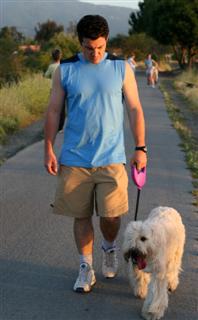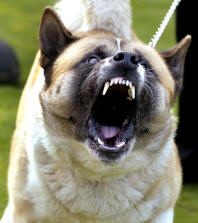Starting
With A Puppy
 When
first introducing leash training,
start by allowing the pup to
lead you to sniff and explore
outside. As you begin to lead,
every pup will initially resist.
Use treats at your side,
then try to get him to follow
by leg patting and coaxing. Praise
any positive response; ignore negatives.
When
first introducing leash training,
start by allowing the pup to
lead you to sniff and explore
outside. As you begin to lead,
every pup will initially resist.
Use treats at your side,
then try to get him to follow
by leg patting and coaxing. Praise
any positive response; ignore negatives.
|
As
you begin to lead, every
pup will initially resist.
Give a tug to get him started,
then try to get him to follow
by leg patting and calling.
|
 If
he takes the leash, don't
allow him to lead you. It is
OK to allow him to bring you
the leash, but if he has it
in his mouth while walking,
you have less control in an
emergency, and it encourages
him to consider chewing the
leash later. There are several
methods to keep the leash out
of his mouth.
If
he takes the leash, don't
allow him to lead you. It is
OK to allow him to bring you
the leash, but if he has it
in his mouth while walking,
you have less control in an
emergency, and it encourages
him to consider chewing the
leash later. There are several
methods to keep the leash out
of his mouth.
-
Don't go anywhere fun when the leash
is in his mouth. If walking,
stop and be boring.
-
Soak the leash in a safe
taste deterrent.
Head
Halters
 A
good alternative for
solving pulling on the leash
is use of a canine head halter.
This halter loops over the nose
and behind the ears similar
to a halter on a horse. The
advantage is that by controlling
the direction of the head, you
easily eliminate pulling without
choking the dog. Introduce Head
collars with treats. It
may still take a while for the dog to
accept, so make it fun.
A
good alternative for
solving pulling on the leash
is use of a canine head halter.
This halter loops over the nose
and behind the ears similar
to a halter on a horse. The
advantage is that by controlling
the direction of the head, you
easily eliminate pulling without
choking the dog. Introduce Head
collars with treats. It
may still take a while for the dog to
accept, so make it fun.
Adult
Dogs
 While
walking, if he begins to pull
quickly turn
180 degrees
and walk in
the new
direction.
You may not make much forward
progress at first, but the dog
will learn he will get
to go in one
direction
faster if he doesn't pull
on the leash. A
second benefit of the "Change
Direction" approach is
that the dog is constantly reminded
that you are leading the walk. You
lead every time you decide to
change directions.
While
walking, if he begins to pull
quickly turn
180 degrees
and walk in
the new
direction.
You may not make much forward
progress at first, but the dog
will learn he will get
to go in one
direction
faster if he doesn't pull
on the leash. A
second benefit of the "Change
Direction" approach is
that the dog is constantly reminded
that you are leading the walk. You
lead every time you decide to
change directions.
The Heel Cue
 This
is a much more advanced event
than merely not pulling on a
leash. The ideal heel is when
the dog walks
closely on your LEFT side.
He matches your pace, and looks
at you whenever you stop.
This
is a much more advanced event
than merely not pulling on a
leash. The ideal heel is when
the dog walks
closely on your LEFT side.
He matches your pace, and looks
at you whenever you stop.

This
Instruction is best learned in a
formal class from an obedience
instructor. You are less likely
to start bad habits. In addition,
the distractions of the other
people and dogs in an obedience
class or with a private
trainer make the training more
reliable. The dog also learns
to follow cues in different
locations.
 Praise
the dog or use a clicker-food
reward, any time he is in the correct
position. If he "forges"
(moves ahead of you), turn in front of
him. As
he strays from the correct position,
use the "Change Direction"
technique. If you turn and change,
he will need to catch up and
pay more attention.
Praise
the dog or use a clicker-food
reward, any time he is in the correct
position. If he "forges"
(moves ahead of you), turn in front of
him. As
he strays from the correct position,
use the "Change Direction"
technique. If you turn and change,
he will need to catch up and
pay more attention.
 Dog
Leash Aggression
Dog
Leash Aggression
A
training foundation needs to
be established first
by
using
the "Learn to Earn"
daily reinforcement
method.
The dog must learn how
to focus on the
pet parent and respond to
"sit" and "down"
in a variety of
locations. Start with
the home and backyard.
When the dog is
responding consistently,
add distractions by
asking a second person t
make noise or try to
entice the dog's
attention away by
bouncing a ball or
squeaking a toy. Try to
keep the dog successful
by introducing small
distractions and
gradually building to
longer ones.
When
the dog has enough
experience ignoring the
distractions and staying
tuned in to the
training, then begin
working with the dog on
walks off the property.
The pet parent needs to:
-
be hypervigilent on walks
(aware of surroundings)
-
control the distance
to the dog's triggers
-
determine what the
reaction distance is (ie.
10ft, a block, etc.) -
at what distance will
the dog still respond to
Instructions?
-
respond as soon as
the dog starts to
react
with a U-turn,
if necessary
using
a knee to physically
guide the dog into the
U-turn.
(Once the dog is
under control
giving the dog lots
of reinforcing
praise.)
-
move farther away
from the stimulus
If the dog
will not focus
on the pet parent
If the dog "freaks"
out then wait it out
until the dog calms
down. It is important to remain
calm, showing emotional
leadership.
Desensitization and
Counter Conditioning can
be worked on to help the
dog gradually learn to
ignore the stimulus
while responding to
instructions and praise
from the pet parent.